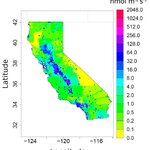Atmospheric

Global emissions of carbon dioxide (CO2), considered the main cause of global warming, increased by 3% last year, reaching an all-time high of 34 billion tons in 2011.
China, the world’s most populous country, also leads the world in greenhouse gas emissions with nearly double the greenhouse gases of the US, and its average emissions of CO2 increased by 9% to 7.2 tons per capita. China is now within the range of 6 to 19 tons per capita emissions of the major industrialized countries. European Union, CO2 emissions dropped by 3% to 7.5 tons per capita while the United States dropped to 17.3…

Methane, a potent greenhouse gas, has been underrated in the quest to discuss carbon dioxide, but it shouldn't be - it has about 23 times the warming effect of CO2. And methane levels are at least one-and-a-half times higher in California than previously estimated, says a new study.
Researchers recently combined highly accurate methane measurements from a tower with model predictions of expected methane signals to revise estimated methane emissions from central California. They found that annually averaged methane emissions in California were 1.5 to 1.8 times greater than previous…

Aerosols from relatively small volcanic eruptions can be boosted into the high atmosphere by weather systems such as monsoons and affect global temperatures, according to a new study.
It has long been thought that a massively energetic eruption was needed to inject aerosols past the troposphere, the turbulent atmospheric layer closest to the earth, into the stable layers of the stratosphere higher up. If an aerosol is in the lower atmosphere, it's affected by the weather and it precipitates back down right away. Once it reaches the stratosphere, it can persist for years, and with that…

The influence of aerosols and clouds represent one of the largest known uncertainties in the scientific understanding of trends in our past global climate - and also hinder predictions of future climate change.
Researchers have now shown that the rate of condensation of water on organic aerosol particles in the atmosphere can be very slow, taking many hours for a particle to change in size. This could have significant consequences for understanding how clouds are formed, affecting climate.
Aerosols are small particles less than 1 micrometer in diameter and clouds are liquid droplets of 1–1,…

'Grey' literature, which led to the "Glaciergate" scandal of 2010 when it was revealed that the rate at which Himalayan glaciers are losing ice (gone by 2035!) was stated as fact even though it was not based on evidence, will no longer be a problem for the Intergovernmental Panel on Climate Change (IPCC).
Because they have declared that grey literature will no longer be grey - any information they choose to use will be considered peer reviewed just by being posted on the Internet by the IPCC.
Most rational people would simply not use grey literature after the errors of the 2007…

How can basically honest scientists using a rigorous methodology have different data? Numerical models are tricky business and while climate scientists are rapidly becoming experts in statistics and creating better models, that was not always the case.
One vital component of getting clean models is accurate calibration. Calibration is life, in science. A satellite temperature record put together by the University of Alabama in Huntsville in 1989 has often been cited by climate change skeptics as evidence of doubt that models showing the impact of greenhouse gases on global warming…

Last week, word came from Prudhoe Bay that sent chills through me as surely as if I’d been standing in the Alaskan North Slope drilling outpost myself. The United States Department of Energy – in collaboration with energy giant ConocoPhillips and the Japanese nationalized minerals corporation – reported success from a month-long test extraction of methane gas tucked into an icy lattice below the permafrost.
These methane hydrates – also called methane clathrates, after the particular crystalline structure of the ice matrix – are found in cold regions (like the Arctic, where low…

Anthropogenic climate change is so anthropomorphic. While we think we have a mighty impact on the atmosphere, sauropod dinosaurs millions of years ago shouldn't be left out of the pollution hall of fame - they alone could have produced enough methane to warm the climate many millions of years ago, according to a numerical model.
Like CO2, methane is a greenhouse gas, but with 23X the warming impact of CO2. It's produced by dying plants and cow burps - and cows share one thing in common with hulking sauropods, distinctive for their enormous size and unusually long necks, that were…

The second-largest mass extinction in Earth's history, the so-called Late Ordovician mass extinction, coincided with a short but intense ice age during which enormous glaciers grew and sea levels dropped.
The Late Ordovician mass extinction occurred about 450 million years ago and was related to climate change, that has been known, but exactly how the climate change produced the extinction has not. A team led by scientists at the California Institute of Technology (Caltech) has created a framework for weighing the factors that might have led to mass extinction and has used that framework to…

LINCOLN, NE – At 11:30pm, after thirteen hours of math ecology talks, I was dead to the world. Almost. I just couldn’t figure out why someone had suddenly parked all the city’s fire engines outside our hotel, or why their sirens sounded so odd.
Despite my best attempts to burrow under the blankets and away from the sound, my brain was slowly returning to life. “Isn’t this tornado country?” I wondered groggily.
The answer – and an adrenaline-fueled acceleration of thought processes – came when a hotel staffer pounded on the door, shouted “Tornado coming – get to the basement!” and…